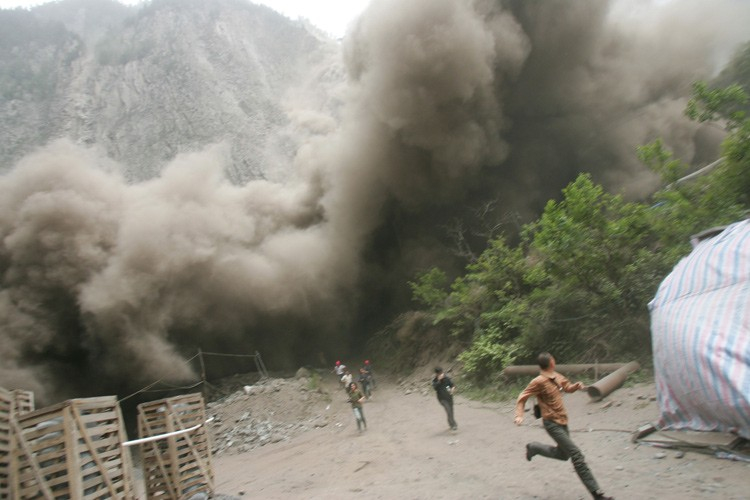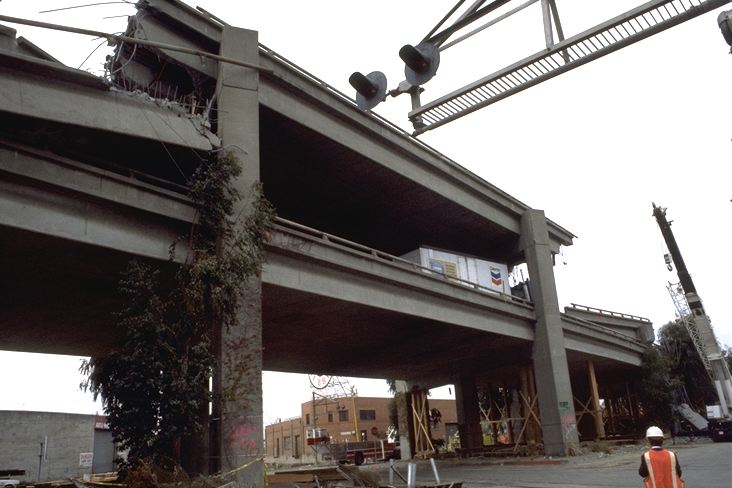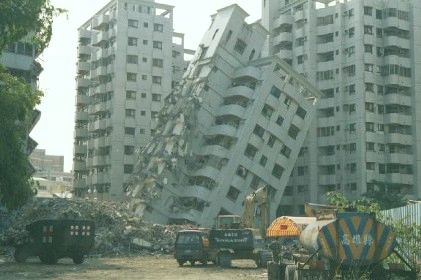Earthquake-triggered landslide in China (2008), collapsed freeway in San Francisco (1989) and toppled building in Taiwan (1999)
 An earthquake is the shaking of the ground cause by seismic waves.
Almost all earthquakes occur when pent up stress in rocks along large,
active faults (like the SAF) is suddenly released as the rock breaks.
Like anything that breaks, it makes 'noise' and this noise comes in the
form of seismic waves that make the ground tremble, though it is not
just sound waves (P waves). Seismic waves propagate through the earth
and along its surface. Anything that produces seismic waves is called an
'earthquake'. Landslides and moving magma in volcanoes make
earthquakes. Nuclear and chemical explosions also produce seismic waves
that can be distinguished from natural earthquakes. In the US, the United States Geological Survey
and its affiliated research institutions are responsible for monitoring
and studying earthquakes, and helping to mitigate their effects. An earthquake is the shaking of the ground cause by seismic waves.
Almost all earthquakes occur when pent up stress in rocks along large,
active faults (like the SAF) is suddenly released as the rock breaks.
Like anything that breaks, it makes 'noise' and this noise comes in the
form of seismic waves that make the ground tremble, though it is not
just sound waves (P waves). Seismic waves propagate through the earth
and along its surface. Anything that produces seismic waves is called an
'earthquake'. Landslides and moving magma in volcanoes make
earthquakes. Nuclear and chemical explosions also produce seismic waves
that can be distinguished from natural earthquakes. In the US, the United States Geological Survey
and its affiliated research institutions are responsible for monitoring
and studying earthquakes, and helping to mitigate their effects.Earthquake stress is built up in rocks when two plates that are trying to move push against one another. Because of friction between the plates at the fault, they cannot slide freely. Instead, they deform (strain) and build up energy, like compressing a spring. When the stress exceeds the friction or the breaking strength of the rocks, the rocks break or slide and in a short period of time - seconds - the energy stored in the deformed rock is released in the form of heat and seismic waves. The process is called elastic rebound. The amount of seismic energy released in an earthquake is measured by its magnitude. The magnitude scale is logarithmic so that it can conveniently describe the vast range of earthquakes possible. Each unit of magnitude corresponds to a factor of ten in ground motion, and a factor of 31.6 in energy. For example, the ground movement during the shake (say in inches) will be ten times greater in a magnitude 6.0 quake than it will in a magnitude 5.0 quake. Similarly, a magnitude 6.0 has 31.6 times as much energy as 5.0. The largest measured earthquake was the 9.5 magnitude Chilean temblor of 1960. Geologists apply specific descriptors to earthquakes according to their magnitude: minor (3.0-3.9), light (4.0-4.9), moderate (5.0-5.9), strong (6.0-6.0), major (7.0-7.9) and great (8.0 or higher). The "Big One" will be a great earthquake. |
But magnitude alone does not tell the whole story. We live in a three-dimensional world so the ground can move in three ways: up-down, left-right (E-W) and forwards-backwards (N-S). Two earthquakes with the same magnitude can produce very different damage because at a given location, one may produce predominantly vertical motion, while the other may cause more horizontal displacement. In general, the stronger the earthquake, the longer it will last. There are two reasons for this: (1) Length of rupture, and (2) travel time for the seismic waves. An earthquake begins where the rock in the fault first breaks below the surface, the so-called hypocenter, or focus. The epicenter is the point on the surface directly above the hypocenter. The rupture then propagates along the fault at many km per sec, momentarily allowing the rock on either side of the fault slip relative to the other. At each point along the rupture, seismic waves are generated. Since the rupture may be hundreds of miles long, it takes a while for the waves from each part to reach a given place. The longer the rupture, the longer the earthquake lasts. The 6.7 magnitude Northridge earthquake lasted about twenty seconds, while the magnitude 9.2 quake in Alaska went for over four minutes. Another significant danger during an earthquake is liquefaction. When certain kinds of water-laden soils are shaken, they momentarily cease to be solid and become somewhat fluid-like, similar to pudding. Any structure on such soil like buildings or freeways tend to sink into the soil and tilt, sometimes toppling over completely. The SAF is the largest earthquake-producing fault in California but it is not the only one. The most active one is the San Jacinto fault. The region that is seismically most active is Cape Mendocino. Other faults that have or will produce big earthquakes are the Hayward, Calaveras, Newport-Inglewood, and Owens Valley faults. The 1994 Northridge earthquake occurred on a relatively minor (and at the time unknown) fault, later called the Northridge blind thrust fault. The quake was notable because it occurred in a heavily populated area. The much larger 7.3 Landers earthquake in 1992 took place in a sparsely populated area of California and resulted in relatively little damage. |



No comments:
Post a Comment